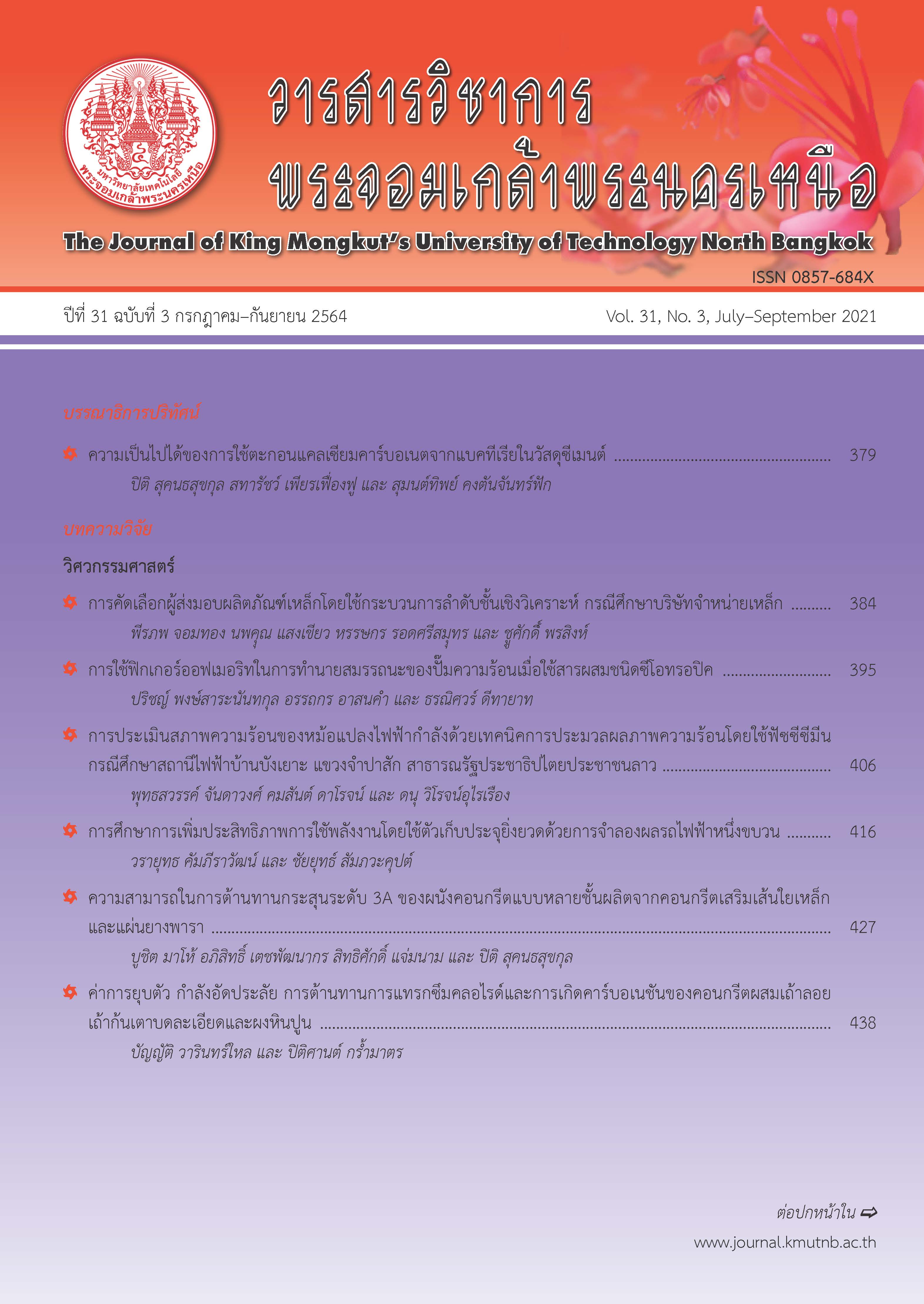ซอฟต์แวร์ป้องกันการเกิดอาการคอมพิวเตอร์วิชันซินโดรม กรณีตรวจหาระยะห่างด้วยภาพใบหน้า
Main Article Content
บทคัดย่อ
คอมพิวเตอร์วิชั่นซินโดรมเป็นอาการเจ็บป่วยที่เกิดจากเพ่งมองจออุปกรณ์สารสนเทศ บทความนี้นำเสนอการพัฒนาซอฟต์แวร์ที่ป้องกันการเกิดอาการด้วยการตรวจหาระยะห่างของตาผู้ใช้กับหน้าจอ เมื่อผู้ใช้มีระยะการมองที่มีความเสี่ยงต่อการเกิดอาการ ระบบจะทำการแจ้งเตือนให้ผู้ใช้ปรับระยะการมองที่เหมาะเพื่อเลี่ยงความเสี่ยงของเกิดอาการ การวัดระยะห่างใช้ภาพที่รับจากกล้องที่เชื่อมกับอุปกรณ์นั้น ๆ แล้วประยุกต์ใช้เทคโนโลยีการตรวจหาใบหน้าเพื่อค้นหาตำแหน่งของดวงตา วิธีการคำนวณเริ่มจากการสร้างเส้นสมมติจากตำแหน่งของกล้องและดวงตา เพื่อที่จะหาค่าตามหลักการตรีโกณมิติ การดำเนินการวิจัยใช้การตรวจหาใบหน้าสามวิธี ได้แก่ ฮาร์ ฮอก และ โครงข่ายประสาทเทียม เพื่อเปรียบเทียบและเลือกวิธีการที่ดีที่สุด การประเมินแบ่งออกเป็นสามด้าน ได้แก่ ด้านความเร็ว ด้านความถูกต้องแม่นยำ และด้านความสามารถในการใช้งานได้ ผลการประเมินซอฟต์แวร์ใช้ความเร็วในการตรวจหาระยะจากภาพขนาด 640*480 เท่ากับ 36 มิลลิวินาทีต่อเฟรม ความถูกต้องและแม่นยำมีค่าร้อยละ 99 ขึ้นไป ค่าเฉลี่ยความคาดเคลื่อนสัมบูรณ์เท่ากับ 0.26 ค่าเฉลี่ยความคลาดเคลื่อนกำลังสองเท่ากับ 0.47 ค่ารากที่สองของความคาดเคลื่อนเฉลี่ยเท่ากับ 0.22 และซอฟต์แวร์มีความสามารถในการใช้งานได้เป็นอย่างดี
Article Details
บทความที่ลงตีพิมพ์เป็นข้อคิดเห็นของผู้เขียนเท่านั้น
ผู้เขียนจะต้องเป็นผู้รับผิดชอบต่อผลทางกฎหมายใดๆ ที่อาจเกิดขึ้นจากบทความนั้น
เอกสารอ้างอิง
[2] L. Mowatt, C. Gordon, A. B. R. Santosh, and T. Jones, “Computer vision syndrome and ergonomic practices among undergraduate university students,” International Journal of Clinical Practice, vol. 72, no. 1, 2017.
[3] HootSuite. (2019). The global state of digital in 2019. [Online]. Available: https://hootsuite.com/resources/digital-in-2019
[4] M. Salehan and A. Negahban, “Social networking on smartphones: When mobile phones become addictive,” Computers in Human Behavior, vol. 29, no. 6, pp. 2632-2639, 2013.
[5] S. Munshi, A. Varghese, and S. Dhar-Munshi, “Computer vision syndrome–A common cause of unexplained visual symptoms in the modern era,” International Journal of Clinical Practice, vol. 71, no. 7, 2017,
[6] American Optometric Association. (2020). Computer Vision Syndrome. [Online]. Available: https://www.aoa.org/patients-and-public/caring-for-your-vision/protecting-your-vision/computer-vision-syndrome
[7] J. S. Jennifer and T. S. Sharmila, “Edge based eye-blink detection for computer vision syndrome,” in Proceedings 2017 International Conference on Computer, Communication and Signal Processing (ICCCSP), 2017, pp. 1–5.
[8] F. Vieira, E. Oliveira, and N. Rodrigues, “iSVC – digital platform for detection and prevention of computer vision syndrome,” in Proceedings 2019 IEEE 7th International Conference on Serious Games and Applications for Health (SeGAH), 2019, pp. 1–7.
[9] N. Julius and E. E. Mustapha, “Take-A-Break notification: An ergonomic application,” in Proceedings of the 6th International Conference on Information Technology and Multimedia, 2014, pp. 390–395.
[10] J. Ho, R. Pointner, H.-C. Shih, Y.-C. Lin, H.-Y. Chen, W.-L. Tseng, and M. Y. Chen, “EyeProtector: Encouraging a healthy viewing distance when Using smartphones,” presented at the Proceedings of the 17th International Conference on Human-Computer Interaction with Mobile Devices and Services, Copenhagen, Denmark, 2015.
[11] T. Toda, M. Nakai, and L. Xinxin, “A close facedistance warning system for straightend neck prevention,” in Proceedings IECON 2015 - 41st Annual Conference of the IEEE Industrial Electronics Society, 2015, pp. 003347–003352.
[12] P. Wasnik and A. Jeyakumar, “Monitoring stress level parameters of frequent computer users,” in Proceedings 2016 International Conference on Communication and Signal Processing (ICCSP), 2016, pp. 1753–1757.
[13] W. Pookhuntod, J. Angskun, and T. Angskun, “EyeGuard: A software module for reducing factors causing computer vision syndrome,” Journal of Science and Technology Mahasarakham University, vol. 37, no. 6, pp. 747–758, 2018 (in Thai).
[14] I. König, P. Beau, and K. David, “A new context: Screen to face distance,” in Proceedings 2014 8th International Symposium on Medical Information and Communication Technology (ISMICT), 2014, pp. 1–5.
[15] Z. Li, W. Chen, and K. Bian, “Look into my eyes: Fine-grained detection of face-screen distance on smartphones,” in Proceedings 2016 12th International Conference on Mobile Ad-Hoc and Sensor Networks (MSN), 2016, pp. 258–265.
[16] M. A. Hossain and M. Mukit, “A real-time face to camera distance measurement algorithm using object classification,” in Proceedings 2015 International Conference on Computer and Information Engineering (ICCIE), 2015, pp. 107–110.
[17] X. Dong, F. Zhang, and P. Shi, “A novel approach for face to camera distance estimation by monocular vision,” International Journal of Innovative Computing, Information and Control, vol. 10, pp. 659–669, 2014.
[18] C. Godard, O. Aodha, and G. Brostow, “Unsupervised monocular depth estimation with left-right consistency,” in Proceedings the IEEE Conference on Computer Vision and Pattern Recognition (CVPR), 2017, pp. 270–279.
[19] S. Bianco, M. Buzzelli, and R. Schettini, “A unifying representation for pixel-precise distance estimation,” Multimedia Tools and Applications, vol. 78, no. 10, pp. 13767–13786, 2019.
[20] G. Bradski, “The openCV library,” Dr. Dobb's Journal of Software Tools, vol. 120, pp. 122–125, 2000.
[21] P. Viola and M. Jones, “Rapid object detection using a boosted cascade of simple features,” in Proceedings of the 2001 IEEE Computer Society Conference on Computer Vision and Pattern Recognition. CVPR 2001, 2001, vol. 1, pp. I-I.
[22] N. Dalal and B. Triggs, “Histograms of oriented gradients for human detection,” presented at the 2005 IEEE Computer Society Conference on Computer Vision and Pattern Recognition (CVPR’05), San Diego, USA, 2005.
[23] D. E. King, “Dlib-ml: A machine learning toolkit,” Journal of Machine Learning Research, vol. 10, no. 60, pp. 1755–1758, 2009.
[24] C. Sagonas, E. Antonakos, G. Tzimiropoulos, S. Zafeiriou, and M. Pantic, “300 Faces in-the-wild challenge: Database and results,” Image and Vision Computing, vol. 47, pp. 3–18, 2016.
[25] J. Kirakowski and M. Corbett, “SUMI: The software usability measurementinventory,” British Journal of Educational Technology, vol. 24, no. 3, pp. 210–212, 2006.

